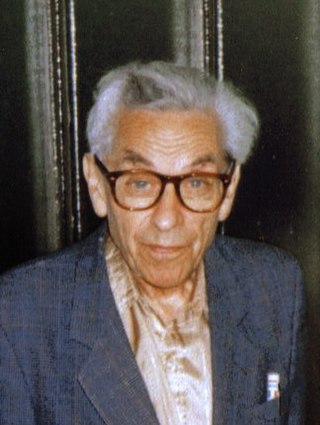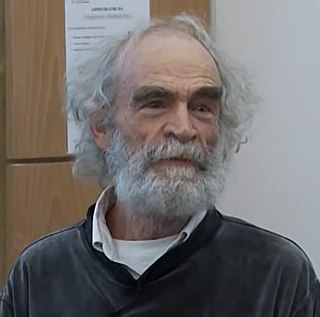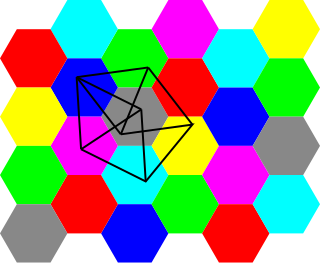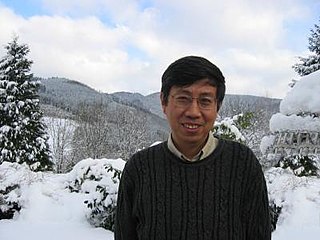
Stephen Smale is an American mathematician, known for his research in topology, dynamical systems and mathematical economics. He was awarded the Fields Medal in 1966 and spent more than three decades on the mathematics faculty of the University of California, Berkeley, where he currently is Professor Emeritus, with research interests in algorithms, numerical analysis and global analysis.
The Nash embedding theorems, named after John Forbes Nash Jr., state that every Riemannian manifold can be isometrically embedded into some Euclidean space. Isometric means preserving the length of every path. For instance, bending but neither stretching nor tearing a page of paper gives an isometric embedding of the page into Euclidean space because curves drawn on the page retain the same arclength however the page is bent.

John Forbes Nash, Jr., known and published as John Nash, was an American mathematician who made fundamental contributions to game theory, real algebraic geometry, differential geometry, and partial differential equations. Nash and fellow game theorists John Harsanyi and Reinhard Selten were awarded the 1994 Nobel Memorial Prize in Economics. In 2015, he and Louis Nirenberg were awarded the Abel Prize for their contributions to the field of partial differential equations.

Paul Erdős was a Hungarian mathematician. He was one of the most prolific mathematicians and producers of mathematical conjectures of the 20th century. Erdős pursued and proposed problems in discrete mathematics, graph theory, number theory, mathematical analysis, approximation theory, set theory, and probability theory. Much of his work centered around discrete mathematics, cracking many previously unsolved problems in the field. He championed and contributed to Ramsey theory, which studies the conditions in which order necessarily appears. Overall, his work leaned towards solving previously open problems, rather than developing or exploring new areas of mathematics.

Hugo Hadwiger was a Swiss mathematician, known for his work in geometry, combinatorics, and cryptography.

Mikhael Leonidovich Gromov is a Russian-French mathematician known for his work in geometry, analysis and group theory. He is a permanent member of Institut des Hautes Études Scientifiques in France and a professor of mathematics at New York University.

Paul D. Seymour is a British mathematician known for his work in discrete mathematics, especially graph theory. He was responsible for important progress on regular matroids and totally unimodular matrices, the four colour theorem, linkless embeddings, graph minors and structure, the perfect graph conjecture, the Hadwiger conjecture, claw-free graphs, χ-boundedness, and the Erdős–Hajnal conjecture. Many of his recent papers are available from his website.

In graph theory, the Hadwiger conjecture states that if is loopless and has no minor then its chromatic number satisfies . It is known to be true for . The conjecture is a generalization of the four-color theorem and is considered to be one of the most important and challenging open problems in the field.

Louis Nirenberg was a Canadian-American mathematician, considered one of the most outstanding mathematicians of the 20th century.
The Beal conjecture is the following conjecture in number theory:

In geometric graph theory, the Hadwiger–Nelson problem, named after Hugo Hadwiger and Edward Nelson, asks for the minimum number of colors required to color the plane such that no two points at distance 1 from each other have the same color. The answer is unknown, but has been narrowed down to one of the numbers 5, 6 or 7. The correct value may depend on the choice of axioms for set theory.

Tian Gang is a Chinese mathematician. He is a professor of mathematics at Peking University and Higgins Professor Emeritus at Princeton University. He is known for contributions to the mathematical fields of Kähler geometry, Gromov-Witten theory, and geometric analysis.
The Oswald Veblen Prize in Geometry is an award granted by the American Mathematical Society for notable research in geometry or topology. It was funded in 1961 in memory of Oswald Veblen and first issued in 1964. The Veblen Prize is now worth US$5000, and is awarded every three years.
In mathematics, arithmetic combinatorics is a field in the intersection of number theory, combinatorics, ergodic theory and harmonic analysis.
János Kollár is a Hungarian mathematician, specializing in algebraic geometry.

Themistocles M. Rassias is a Greek mathematician, and a professor at the National Technical University of Athens, Greece. He has published more than 300 papers, 10 research books and 45 edited volumes in research Mathematics as well as 4 textbooks in Mathematics for university students. His research work has received more than 19,000 citations according to Google Scholar and more than 5,800 citations according to MathSciNet. His h-index is 49. He serves as a member of the Editorial Board of several international mathematical journals.
A classical problem of Stanislaw Ulam in the theory of functional equations is the following: When is it true that a function which approximately satisfies a functional equation E must be close to an exact solution of E? In 1941, Donald H. Hyers gave a partial affirmative answer to this question in the context of Banach spaces. This was the first significant breakthrough and a step towards more studies in this domain of research. Since then, a large number of papers have been published in connection with various generalizations of Ulam's problem and Hyers' theorem. In 1978, Themistocles M. Rassias succeeded in extending the Hyers' theorem by considering an unbounded Cauchy difference. He was the first to prove the stability of the linear mapping in Banach spaces. In 1950, T. Aoki had provided a proof of a special case of the Rassias' result when the given function is additive. For an extensive presentation of the stability of functional equations in the context of Ulam's problem, the interested reader is referred to the recent book of S.-M. Jung, published by Springer, New York, 2011.

Jonathan Micah Rosenberg is an American mathematician, working in algebraic topology, operator algebras, K-theory and representation theory, with applications to string theory in physics.











